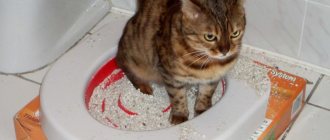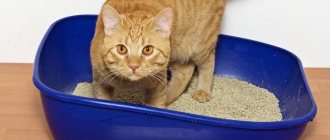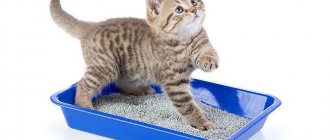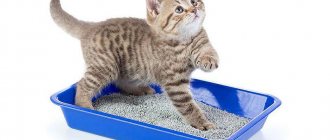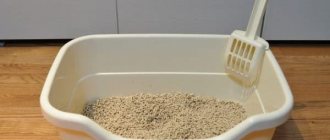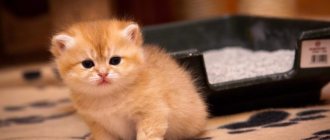Toilet training is something that many cat owners take for granted. Even rescued cats seem to instinctively know how to use the litter box by copying their mothers. However, some felines may not have survived this important socialization. Thus, older cats may need to be toilet trained from scratch or they will defecate outside the litter box.
Do not use a covered litter box as this may frighten a cat who is not familiar with the process. Use unscented litter that is similar to your cat's usual outdoor surfaces. Leave the litter box in a place where the cat can have privacy, such as behind a plant.
An adult cat can learn to use the litter box correctly after training. There may be a little confusion along the way, such as sleeping in a litter box. Over time, your cat will begin to understand what is expected of her.
Why doesn't an adult cat use the litter box?
Some cats are homeless or feral. This means they never received the socialization needed to become a pet. Sometimes a kitten is born into the family home but is rejected by its mother.
This means he was never taught basic functions. Some cats are also abused by other pets. This could make them afraid to use the litter box due to the smell. Another animal could even "stand guard" over the litter box, preventing your cat from entering.
© shutterstock
True to size
Let's decide on the choice of tray and filler. Everything is simple here, but! Completely discard the seemingly logical conclusion: “a small kitten means a small tray.” This is a common misconception among new owners. Cats love consistency and quite the opposite - change. They get so used to their tray that they may not accept a new one. So when choosing a tray, be guided by the future size of your pet - you definitely won’t go wrong.
The role of a tray can be performed by any plastic container with high (4 cm) sides. It must be strong and wear-resistant based on a service life of 15-20 years. Curved edges are a good idea - cats love to rest their paws on them. The tray may have a removable plastic grid, but there is no obvious benefit from such a design - the tray will have to be washed completely and more often than usual.
Teaching an adult cat to use the litter box
Cats are smart animals. This means that even the grumpiest adult cat can be trained to defecate in the litter box. You need to make the experience attractive to her.
- Do not use a closed litter box . Covering the litter box with a hinged lid will hide the sight and smell of cat waste. However, cats feel vulnerable when they are doing their thing. If they are inside a strong box with no easy way out, they may become stressed.
- Do not use scented litter . If you have a cat that is not spayed, his urine will smell strong. Resist the temptation to mask it with a flavorful filler. Cats are led by the nose. If they find the smell of the litter box scary, they will stay away.
- Have multiple trays . You might think it would be helpful if your cat only has one litter box. However, they will learn faster if they have multiple toilets.
- Make the trays uniform in size and shape . They should have low edges so that an adult cat can get in and out easily. However, you can experiment with different brands of litter.
Once you've completed these basic steps, you'll be ready to begin toilet training. Once you have the proper equipment, all you need is patience. This is a different problem than when your cat suddenly stops using the litter box.
Filler selection
The filler is selected under the tray.
clumping
Available with or without flavoring. The clumping product is hygienic and easily absorbs moisture and unpleasant odors. The main rule of any litter: the smaller the kitten, the smaller the granules.
Zeolite
Zeolite filler is more expensive than wood filler, but is consumed more economically and absorbs moisture better. It does not stick to the kitten’s paws or fur if a special mat is placed under the tray.
Woody
Cats can taste the litter. The safest option in this case is wood. But without a special rug, the kitten will carry it around the apartment on its paws.
Grain and pulp
Both types are environmentally friendly, relatively inexpensive and made from organic substances. If the kitten accidentally swallows particles of the filler, it’s not scary. Grain and pulp products clump easily.
Silica gel (hazardous to animals if eaten)
One of the most expensive types. This is a substance that is placed in boxes with shoes and bags to absorb moisture and odors. The silica gel filler does not stick to the kitten's fur and paws and does not create a stench, but if there is too much water in the tray, a puddle may form.
It is best to place this litter under the net so that the kitten does not accidentally eat it.
No filler
Need a self-cleaning tray. There is no point in giving up filler in a conventional device. All problems can be solved in other ways:
- spreads on its paws - buy a special mat, then all the granules will remain on it;
- refuses to use - most likely, the kitten does not like litter with a smell or too hard granules;
- better than newspapers - printing houses use toxic ink, the fumes of which are dangerous;
- expensive - the cheapest filler is wood.
How to litter train an adult cat
Litter training an older cat is similar to training a kitten. The only difference is that it will take longer. Young cats have spongy brains that take in a lot of information. They also imitate other cats. An older cat will have learned different habits and therefore may appear more stubborn.
Think carefully about where to place the tray. As cats get older, they lose control of their bladder. This means they will appreciate trays in multiple locations.
If you live in a multi-story building, it is very important to have at least one litter box on each floor. Place litter boxes where your cat can find them, but not in an area that is too open. Make sure you keep the litter box a reasonable distance from your cat's bed and food.
If your cat is determined to eliminate, calmly pick her up and place her in the litter box. As soon as she does the deed, make a big fuss. Tell your cat how good she is and give her a treat. Soon, using the litter tray will become a source of pleasure for him.
© shutterstock
Dig around, rustle
The natural instincts of the cat family can make your task much easier. All cats love to rustle and rummage in their litter box, which definitely makes you think about litter. This is beneficial for both you and your pet - on the one hand, the fillers absorb moisture and greatly simplify cleaning the tray, and on the other hand, they give the cat the opportunity to dig around to his heart's content. Pet stores offer a wide range of fillers - natural (sawdust and sawdust granules, zeolite or clay) and artificial origin (silica gel). The latter also have deodorizing properties.
An adult cat has stopped going to the litter box
There are many reasons why an older cat may stop using the litter box. These may be medical or psychological. Some of the problems that can cause urinary incontinence in older cats may include:
- Stress . The most common reasons why cats stop using the litter box are stress and anxiety. If something has changed in your home, your cat may have difficulty adapting.
- Diarrhea . If your cat has an upset stomach, she may have intended to use the litter box but didn't get around to it.
- Urinary tract infections or bladder stones . A cat with a UTI may make regular, fruitless trips to the litter box. Since it will be painful, he may think the problem is with the bedding. If your cat cries during elimination, she may have a UTI and require antibiotics.
- Old age . As cats get older, they may develop feline dementia (cognitive dysfunction). Loss of bladder and bowel control is one of the first symptoms.
However, there may be another reason why an older cat does not use the litter box. Make sure none of the following is the problem:
- Mobility . An adult cat with stiff and wobbly legs may struggle to reach the litter box.
- Not enough privacy . Cats want to go to the toilet in peace. If the litter box is too close to people or their food bowl, cats will feel uncomfortable.
- Negative associations . Has your cat recently recovered from a health problem? She may think that using the litter tray made her sick.
- Changing your routine . Have you moved the tray or changed the filling in it? Adult felines are easily disturbed by this change.
- Too much filler . Cats love shallow bedding. If you apply too much, it may avoid going into the tray.
- Contaminated litter . Are you changing the litter in the litter tray enough? If your cat's litter is dirty, she may not want to get too close. Make sure the litter box is cleaned at least once a day.
- Territorial problems with another cat . If another cat is dominant over your adult pet, she may view the litter box as her territory.
There is also a chance that your cat will choose to get rid of something else. You can fix this by changing their filler.
Article Author: Richard Parker I'm Richard, I have experience in all matters related to feline health, behavior, grooming techniques and general pet care. Richard graduated with a degree in journalism in 2008. He is the proud owner of 5 adult cats (all adopted stray breeds), including an older cat who is now 20 years old.
Noble origins
If you have not yet decided on a friend’s candidacy and are at the planning stage, then you can solve the problem, as they say, “at the root.” Of course, it is possible to shelter a cat from the street, thereby committing a noble deed. But raising a cat with good manners from a yard “Murzik” in the hundredth generation is not an easy task. If you feel that you can’t cope, take a pet of “noble origin”.
Meet the prospective pet's mother. To do this, come visit the breeders. Look around and smell. If the mother cat looks well-groomed and neat and does not reveal her presence in any way, don’t hesitate to take the kitten. As a rule, cats are trained in all the basics of cleanliness and instill in their kittens a love of hygiene.
And it’s doubly good if the owners themselves taught the younger generation to use the litter box, which is not uncommon among professional breeders. As a rule, purebred kittens are given away no earlier than 3-6 months of age.
However, if no one explained to the baby how to go to the toilet, then that’s okay too.
Be patient - you will need it. But it all depends on your pet - some people pick it up literally on the fly, with others you will have to repeat the lesson several times.

